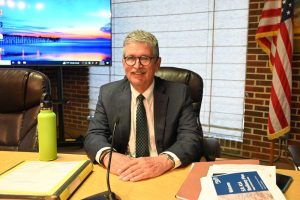
To include your event in the Briefing and Live Calendar, please fill out this form.
Weather: Mostly cloudy. A slight chance of showers in the morning, then a chance of showers in the afternoon. Highs around 70. Temperature falling into the mid 60s in the afternoon. Northeast winds 10 to 15 mph. Chance of rain 50 percent. Tuesday Night: Mostly cloudy. A chance of showers, mainly in the evening. Near steady temperature in the lower 60s. East winds 5 to 10 mph. Chance of rain 40 percent.
Today at the Editor’s Glance:
In Court: No felony court docket today.
The Palm Coast City Council meets in workshop at 9 a.m. at City Hall, followed by a meeting as soon as the workshop business is concluded. The council will consider approving a new lease with Loopers, the restaurant taking the place of the Green Lion at Palm Harbor Golf Club. See background here. The council will also consider approving a contract to develop a master plan for the city’s parks and recreation future. For agendas, minutes, and audio access to the meetings, go here. For meeting agendas, audio and video, go here.
The Community Traffic Safety Team that normally meets today will not meet this month. Its next scheduled meeting is on Jan. 10.
The Flagler County Planning Board meets at 5:30 p.m. at the Government Services Building, 1769 East Moody Boulevard, Bunnell. See board documents, including agendas and background materials, here. The board will consider a rezoning in Plantation Bay that would allow for up to 272 new houses. Watch the meeting or past meetings here.
The St. Johns River Water Management District Governing Board holds its regular monthly meeting at its Palatka headquarters at 10 a.m.. The public is invited to attend and to offer in-person comment on Board agenda items. A livestream will also be available for members of the public to observe the meeting online. Governing Board Room, 4049 Reid St., Palatka. Click this link to access the streaming broadcast. The live video feed begins approximately five minutes before the scheduled meeting time. Meeting agendas are available online here.
Flagler Tiger Bay Club: The club welcomes Claire Metz, the veteran WESH 2 News reporter, as the keynote speaker of the holiday dinner celebration, starting at 6 p.m. at Hammock Dunes Club, 30 Avenue Royale, Palm Coast. $65 for members, $75 for guests.

Fantasy of Lights at Palm Coast’s Central Park: The Rotary Club of Flagler County hosts its 17th Annual Fantasy Lights Festival at Central Park in Town Center, through Dec. 30, 6:30-9 p.m. each night. Fantasy Lights is free self-guided walking tour around Central Park with over 50 large animated light displays, festive live and broadcast holiday music, holiday snacks and beverages. A favorite for the kids is Santa’s House and Village with a collection of elf houses festively painted and nestled among the lights, warm fire to roast marsh mallows or create smores, and encircling the village is Santa’s Merry Train Ride. See the full brochure here and the nightly schedule of events https://flaglerlive.com/wp-content/uploads/Fantasy-Lights-Program-2022_FINAL.pdf#page=7
For more information, please contact Bill Butler at 386-986-3760 or 386-445-0598 or email: [email protected].
World Cup: Argentina and Croatia play their semi-final match at 2 p.m. France and Morocco play on Wednesday.
Keep in Mind: FEMA has extended the deadline into January for Flagler County Hurricane Ian survivors to apply for federal disaster assistance: The Federal Emergency Management Agency has extended the deadline until January 12. The Disaster Recovery Center is in a large tent located near the arena in the center of the fairground’s property, 150 Sawgrass Road, Bunnell. Hours of operation are 8 a.m. to 7 p.m. Disaster Recovery Centers serve as FEMA’s local outreach offices to provide disaster survivors with information from it, as well as from Florida state agencies and the U.S. Small Business Administration. Survivors can get help applying for federal assistance and disaster loans, update applications and learn about other resources available. Survivors can apply for disaster assistance at disasterassistance.gov, by calling 800-621-3362 from 7 a.m. to 11 p.m. Eastern Time, or by using the FEMA mobile app. Those who use a relay service such as video relay service (VRS), captioned telephone service, or others, will need to provide FEMA the number for that service. Those who have insurance are encouraged to file a claim for damages to homes, personal property, and vehicles before applying for FEMA assistance. FEMA cannot duplicate other sources of assistance may have been received.
In Coming Days:
Notably: This could be a sunburst of a day. From the Times: “Scientists at a federal nuclear weapons facility have made a potentially significant advance in fusion research that could lead to a source of bountiful energy in the future, according to a government official. The advance is expected to be announced Tuesday by the Department of Energy, which said a “major scientific breakthrough” was made at Lawrence Livermore National Laboratory in California. […] Fusion that could be produced in a controlled fashion on Earth could mean an energy source that does not produce greenhouse gases like coal and oil, or dangerous, long-lived radioactive waste, as current nuclear power plants do.” But is limitless energy a good thing? Would we not do with it what people suddenly made millionaires by the lottery do with their lives–spiral into perdition?
Now this: It seems like a good time for a reminder.
Flagler Beach Webcam:
![]()
The Live Calendar is a compendium of local and regional political, civic and cultural events. You can input your own calendar events directly onto the site as you wish them to appear (pending approval of course). To include your event in the Live Calendar, please fill out this form.
January 2026
Free For All Fridays With Host David Ayres on WNZF
Friday Blue Forum
‘Lady Day at Emerson’s Bar and Grill,’ the Billie Holiday Story, at City Rep Theatre
Flagler Beach Farmers Market
Coffee With Flagler Beach Commission Chair Scott Spradley
Grace Community Food Pantry on Education Way
Second Saturday Plant Sale at Washington Oaks Gardens State Park
American Association of University Women (AAUW) Meeting
‘Lady Day at Emerson’s Bar and Grill,’ the Billie Holiday Story, at City Rep Theatre
For the full calendar, go here.

I read how he wanted to tell Bill he wasn’t lazy. He was just tired. He realized now it had all been a horrible mistake–the world. He knew he created not with any plan in mind. He created just because he felt so lonely–that was all. He was so lonely and now it was all out of his control. He said he was an atheist he realized, but only a true atheist believes in God. Therefore, maybe he wasn’t an atheist because he didn’t know if he believed in himself anymore. He said he was Peter Pan. He said he wanted something removed. He said he felt like a hermaphrodite.
–From Scott McClanahan’s Crapalachia (2013).





































Laurel says
I’ve thought fusion was the way to go for a long time now. Getting closer is great! Let’s do it!
Ray W. says
Like Laurel, I agree with her applauding a scientific achievement of great magnitude. I find it easy to argue that government investments in searching for new forms of energy efficiency are to be supported and, perhaps, expanded.
One overdue area of investment should be research into advances in solar energy. I occasionally heard my father talk of hitchhiking to visit a cousin living in Miami during his 30-day leave granted before his crew flew to Italy to go into combat.
As an aside, my father stopped in Daytona Beach on his way to Miami; he stayed a few days after learning that a WACS training facility was in the area. At the age of 18, my father later claimed, he decided he wanted to live in Daytona Beach after the war.
On arriving in Miami, he checked into an oceanfront hotel, one of the perquisites available to soldiers on leave. He then searched out his cousin’s home. On the way, he noticed large numbers of homes with black pipes protruding across their roofs. He asked his cousin the purpose of the black pipes. His cousin explained that diesel fuel had to be shipped to Miami to provide power for the local utility company, which meant that electricity prices were unusually high. Today’s national grid, excepting Texas, just didn’t exist back then. Many Miami homes at that time were built with this crude form of solar energy conversion in order to heat water, which was stored in water tanks.
With the advent of cheaper means of transporting energy into the Miami area, public utility electricity prices became more competitive and the individual response to those high energy prices slowly went away.
Today, Florida’s utility companies engage in well-funded efforts to modify our constitution in their effort to make it harder for individuals to take it upon themselves to install solar panels on their own roofs. This struggle between the individual and the collective will likely play itself out in a number of years. Oddly, it is difficult for individuals to get permits to install their own solar panels and then hook them into the electric grid. Yes, I suppose someone could purchase their own panels and batteries and go off the grid, but cities don’t issue certificates of occupancy for new homes if they aren’t hooked into the grid.
Years ago, I watched a minidocumentary about a British community that collectively raised the funds to install their own wind turbine. Some of the savings were used to eventually purchase and install two additional more-efficient wind turbines. Now, profits are plowed back into their homes, with additional layers of insulation and new insulated windows and doors for each home. Each improvement cuts community energy needs and increases profits. The community interviews all new homeowners, seeking out young couples who accept the communal belief in shared responsibility for homecare and energy conservation. Yes, in the early years, many American communities purchased diesel generators and had their own neighborhood grids. Indeed, my paternal grandfather, an electrician who serviced field hospitals in WWI, opened a business with two partners, building electric motors and remanufacturing older electric motors. When the partners proposed mortgaging their three homes to fund the establishment of a city generating company in the early 1920’s, my grandfather backed out; he was too cautious about mortgaging his home. He became a postman. His partners, according to family lore, built the Greensboro city electric company into what is now Duke Power.
In 150 years, we have gone from the wealthy having generators in their mansions to utility companies dominating electricity production. Perhaps it is time to begin focusing on returning to community or individual power production. Energy losses from transmitting power from distant power sources to individual homes and businesses are significant. Plus, we are now fully aware of the vulnerability to acts of terror and destruction at substations that distribute electricity. A few rifle shots and entire communities lose power. The war in the Ukraine is more than enough proof that reliance on central sources of electricity provide a measure of vulnerability to all of us during extraordinary events.
As an aside, years ago, my oldest son earned a state certification in solar panel installation in hopes of immediately starting his own small business. To his discomfort, he learned that state regulations forbad his efforts; he had to work for another company for three years before he could even apply for a license. Not being one who liked working for others, he went back to a business he started with my younger son just before age 10: mowing lawns. That first summer, they had four lawns and used my residential equipment. By the time they were 14 (stepbrothers), they owned a service with a friend from youth baseball with 40 customers. By 16, they had 60 lawns. Yes, I drove them everywhere until he got his license. Yes, I mowed right beside them. Yes, I worked all day, then drove home and worked with them until dark and on weekends. When they went to summer baseball camp at Stetson for a week, I mowed their lawns. My record with the three boys is 28 lawns in one day. They bought me a tank of gas every month and kept the rest. When they were sixteen, they owned their own F-150, had a 6X10 trailer, with a 48-inch hydro-tractor, a 36-inch walk-behind, a 22-inch push mower for backyards with narrow fence gates, and a full panoply of Stihl commercial equipment, with roughly $15,000 in equipment and tools on the trailer, all purchased with money they earned. One son kept the books, did the billing, met with customers, etc. The other son repaired and maintained the equipment, under my supervision.
Today, his service is fully electric, including hedge trimmers and chain saws. He sold off all of his old large-lot homes and started anew. He limits his services to a brand-new subdivision of high-end homes west of New Smyrna Beach. The lots sizes are relatively small, with most homes backing onto large lakes. His customers love the fact that he has switched to an all-electric service. Echo released a new line of commercial hand-held equipment that he says is more powerful than gas-powered equipment and much more efficient than his first generation of electric equipment; battery life is much longer. He can start at 7:00 am, because the noise level is so low. He plugs in his chargers at customer’s homes and recharges the batteries as he mows. He has a meter installed on his home recharging circuit which measures the kilowatt hours used to recharge his batteries at home. He once told me that one week’s cost to recharge his batteries at home was 13 cents. His small commercial twin-blade mower weighs just over 70 pounds, which he easily lifts into his truck bed, so he no longer needs a trailer; everything fits into the extended bed of his truck and his garage when he is done. 18 months into this new format, his only mechanical issue arose when grass clogged one of the housings beneath the electric motor on the mower deck; he didn’t realize that it needed to be cleared of debris periodically; he had to change a gearset between the two blades, covered by the warranty after he spoke with a customer representative who mailed the parts directly to his home. No changing plugs, air filters, mixing oil and gas, buying gas, changing crankcase oil and filters, cleaning clogged exhaust ports and mufflers, or having to pull-start motors. Just sharpen all blades periodically, including chainsaw links, replace the occasional edger blade, lubricate the hedge trimmer blades, and add trimmer string when needed.
My point is that technology is constantly changing. What was not possible three years ago, due to relatively poor battery life and extra weight is now easily available to all people. The prices are competitive with gas-powered equipment. As I researched the issue, I learned that Echo long had a contract with a Chinese company that built its commercial products to Echo specifications. Echo built a new American factory and completely redesigned their products. The new electric motors are more powerful, lighter and more efficient. The new batteries (oddly 56 volts, lower than the older models’ 58 volts) last longer before needing recharging. With planning, he can mow without stoppage all day.
The EIA publishes a comparison of energy production prices every five years, titled: Projected Costs of Electricity Generation. The last report issued in 2020; it surveyed 243 plants in 24 countries. The authors cautioned that the comparisons are general in nature, not specific, because each plant has its own different needs and costs, based on distance from fuel sources and climate conditions. For example, my youngest son, once a train dispatcher for BNSF, told me of a coal-fired power plant in a remote area of the upper west. It was the only customer for a coal mine. The short rail line went from the mine to the plant. The rail line had a dispatcher, an engineer and a conductor, but it ran only once per day, providing enough coal for the next day’s power, plus a reserve. I looked it up. Built long ago, it serviced the small community before it was hooked into the national grid. It cannot be the most efficient of coal-fired generating plants, but it still runs. By definition, it would be an outlier to the costs reported in the EIA study. The report studies existing plants, not the latest generation of plants being planned or built. Fuel efficiencies of combined cycle gas turbine plants are constantly improving. New generation nuclear plants are likely to be far more efficient than 60-year-old plants.
The EIA figures are as follows:
Coal: Roughly $110 per mHW.
Gas: Just under $50 per mHW
Nuclear: $70 per mHW
Onshore wind: Just over $40 per mWH
Offshore wind: Just over $60 per mWH
Utility Scale Solar: Just under $50 per mWH
With ever-improving technology, I expect that nuclear, solar and wind power plants will become more efficient and cost-effective, compared to coal and natural gas plants, but we need to invest more in commercial and residential solar technology.